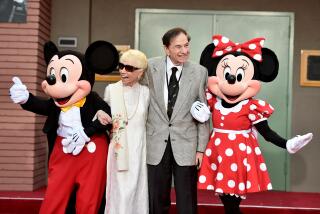Disney’s Older Brother at Last Receives His Due
- Share via
After standing in the shadow of his brother Walt for nearly 75 years, Roy Oliver Disney will receive some belated recognition at 11:30 a.m. today when he receives a star on Hollywood Boulevard, in front of the El Capitan theater.
Born in Chicago in 1893, eight years before Walt (who was honored in 1960 with one of the first 1,500 stars on the Walk of Fame), Roy encouraged his younger brother to pursue his interest in art, despite the opposition of their stern father. Roy became a banker and moved to Glendale in 1920; the dry climate helped combat the tuberculosis he caught in the Navy. Walt joined him during the summer of 1923, after his first studio in Kansas City, Mo., went bankrupt. Roy helped Walt raise the money to set up a studio to make the live-action animation “Alice” comedies. A small storefront became the Disney Brothers Studio, which Walt changed to the Walt Disney Studio in 1926.
“Dad always defended the change, saying it was better to have one person out in front than to try to sell two brothers, and that Walt was good with the public and he wasn’t,” says Roy Edward Disney, son of Roy Oliver and vice chairman of the board of the Walt Disney Co. “He could be effective in that role when he had to be, but Dad really preferred not to be the front man.”
As the fledgling studio grew, Roy managed the finances, an often difficult job because Walt wanted to do things that were new, better and experimental. The cost of an exciting project didn’t interest him: Expenditures for “Snow White and the Seven Dwarfs” (1937) topped $2 million--eight times the original estimate of $250,000. Roy had to find ways to finance experiments that ranged from the introduction of the Technicolor process into animation to the creation of Disneyland. Although the relationship between the brothers was usually loving and supportive, they occasionally fought fiercely. After one particularly acrimonious dispute, Walt sent Roy an American Indian peace pipe, which he displayed in his office.
Roy’s greatest challenge came after Walt’s death in 1966. Abandoning plans to retire, he devoted his last years to completing the two projects dearest to his brother’s heart: Walt Disney World in Florida and the California Institute of the Arts. Roy E. Disney recalls, “Walt died and the world believed that was the end of the company--so many CEOs called Dad’s office wanting to know its price that his secretary was turning them down without even calling him to the phone. It was not a good time to get big loans, and by then his conviction that he was not a creative guy had become so strong that tackling such ambitious projects scared him. But he stuck his chin out and made sure the things his little brother had wanted got done.”
Students began attending CalArts in September 1970; Walt Disney World opened in Florida to unprecedented crowds on Oct. 1, 1971. Exhausted by his efforts, Roy Oliver Disney died on Dec. 20, 1971, of a cerebral hemorrhage.
When the inevitable question of what his father--and uncle--would think of the Walt Disney Co. today comes up, Roy E. Disney notes that, “the bottom line would certainly please him,” but he cautions against further speculation: “Second-guessing either one of those guys is a futile exercise. Guys were fired for second-guessing Walt for many years; I wouldn’t want to try it with Dad, either--I may see him again.”
More to Read
The biggest entertainment stories
Get our big stories about Hollywood, film, television, music, arts, culture and more right in your inbox as soon as they publish.
You may occasionally receive promotional content from the Los Angeles Times.










